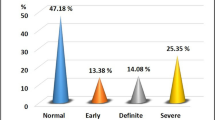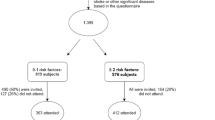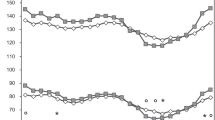Abstract
Type I diabetic patients (DM-1) with an elevated urinary albumin excretion (UAE>30 mg/24 h) have a high cardiovascular risk. However, DM-1 patients with normal UAE have incipient abnormalities of the cardiovascular and nervous systems, such as elevations of blood pressures, increases in arterial stiffness and deterioration of autonomic nervous function. We studied the interrelationships of these abnormalities in normoalbuminuric DM-1 patients. In 76 patients, we performed two cardiovascular reflex tests (deep in- and expiration test (IE test) and lying-to-standing test (LS test)), and determined aortic pulse wave velocity (PWV), local arterial compliances of the common carotid, femoral and brachial arteries, and 24-h blood pressures. The ΔRRmax value of the LS test was associated with aortic PWV (negatively) and the compliance coefficients of the carotid, femoral and brachial arteries. Per 100-ms increase in ΔRRmax, pulse wave velocity decreased by 0.39 m/s, compliance coefficients of the carotid, femoral and brachial arteries increased by 0.06, 0.08 and 0.05 mm2/kPa, respectively. These associations were independent of age, 24-h mean arterial pressure and 24-h heart rate. Increases in arterial stiffness were associated with increases in 24-h systolic and pulse pressure (per 1 m/s increase in PWV, systolic and pulse pressure increased by 2.1 and 1.7 mmHg, respectively). In normoalbuminuric DM-1 patients, deterioration of autonomic nervous function is associated with an increase in arterial stiffness, which, in turn, was associated with, and may cause, increased systolic and pulse pressure. These findings suggest that preventive strategies targeting autonomic dysfunction may reduce cardiovascular morbidity in diabetes.
This is a preview of subscription content, access via your institution
Access options
Subscribe to this journal
Receive 12 digital issues and online access to articles
$119.00 per year
only $9.92 per issue
Buy this article
- Purchase on Springer Link
- Instant access to full article PDF
Prices may be subject to local taxes which are calculated during checkout
Similar content being viewed by others
References
Green A et al. Relative mortality of type 1 (insulin-dependent) diabetes in Denmark: 1933–1981. Diabetologia 1985; 28: 339–342.
Borch-Johnsen K et al. The natural history of insulin-dependent diabetes in Denmark. 2. Long-term survival: who and why. Diabetic Med 1987; 4: 211–216.
Deckert T et al. Cohort study of predictive value of urinary albummin excretion for atherosclerotic vascular disease in patients with insulin-dependent diabetes. Br Med J 1996; 312: 871–874.
Messent JWC et al. Prognostic significance of microalbuminuria in insulin-dependent diabetes mellitus: a twenty-three year follow-up study. Kidney Int 1992; 41: 836–839.
van Ittersum FJ et al. Ambulatory blood pressures and autonomic function in normoalbuminuric type I diabetic patients. Nephrol Dial Transplant 1998; 13: 326–332.
Kool MJ et al. Vessel wall properties of large arteries in uncomplicated IDDM. Diabetes Care 1995; 18: 618–624.
Ziegler D et al. The natural history of somatosensory and autonomic nerve dysfunction in relation to glycaemic control during the first 5 years after diagnosis of Type 1 (insulin-dependent) diabetes mellitus. Diabetologia 1991; 34: 822–829.
Giannattasio C et al. Progression of large artery structural and functional alterations in Type I diabetes. Diabetologia 2001; 44: 203–208.
Lambert J et al. Sodium, blood pressure and arterial distensibility in insulin-dependent diabetes mellitus. Hypertension 1997; 30: 1162–1168.
Giannattasio C et al. Early impairment of large artery structure and function in type I diabetes mellitus. Diabetologia 1999; 42: 987–994.
Poulsen PL, Hansen KW, Mogensen CE . Ambulatory blood pressure in the transition from normo- to microalbuminuria. A longitudinal study in IDDM patients. Diabetes 1994; 43: 1248–1253.
Poulsen PL et al. 24-h blood pressure and autonomic function is related to albumin excretion within the normoalbuminuric range in IDDM patients. Diabetologia 1997; 40: 718–725.
Jensen-Urstad K, Reichard P, Jensen-Urstad M . Decreased heart rate variability in patients with type 1 diabetes mellitus is related to arterial wall stiffness. J Int Med 1999; 245: 57–61.
Rydén Ahlgren Å et al. Increased aortic stiffness in women with type 1 diabetes mellitus is associated with diabetes duration and autonomic nerve function. Diabetic Med 1999; 16: 291–297.
Ewing DJ . Analysis of heart rate variability and other non-invasive tests with special reference to diabetes mellitus. In: Bannister R (ed). Autonomic Failure. Oxford University Press: Oxford, 1992 pp 312–333.
Wieling W . Non-invasive continuous recording of heart rate and blood pressure in the evaluation of neurocardiovascular control. In: Bannister R (ed). Autonomic failure. Oxford University Press: Oxford, 1992 pp 291–311.
Kool MJ et al. Evaluation of reproducibility of a vessel wall movement detector system for assessment of large artery properties. Cardiovasc Res 1994; 28: 610–614.
Van Bortel LMAB et al. Non-invasive assessment of local arterial pulse pressure: comparison of applanation tonometry and echo-tracking. J Hypertens 2001; 19: 1037–1044.
Demolis PD et al. Non-invasive evaluation of the conduit function and the buffering function of large arteries in man. Clin Physiol 1991; 11: 553–564.
O'Rourke MF . Function of arteries as vascular conduits. In: O'Rourke MF (ed). Arterial Function in Health and Disease. Churchill Livingstone: Edinburgh, London, Melbourne, New York, 1982 pp 53–64.
Wilkinson IB et al. Reproducibility of pulse wave velocity and augmentation index measured by pulse wave analysis. J Hypertens 1998; 16: 2079–2084.
Hoeks AP . Non-invasive study of local mechanical arterial characteristics in humans. In: Safar M (ed). The Arterial System in Hypertension. Kluwer Academic Publisher: Dordrecht, 1993 pp 119–134.
van Ittersum FJ et al. Analysis of 24-hour ambulatory blood pressure monitoring (ABPM): what time period to assess blood pressures during waking and sleeping ? J Hypertens 1995; 13: 1053–1058.
Fagard R et al. Prediction of the actual awake and asleep blood pressures by various methods of 24 h pressure analysis. J Hypertens 1996; 14: 557–563.
Benetos A et al. Arterial alterations with aging and high blood pressure. A noninvasive study of carotid and femoral arteries. Arterioscler Thromb 1993; 13: 90–97.
Mangoni AA et al. Heart rate-dependence of arterial distensibility in vivo. J Hypertens 1996; 14: 897–901.
Mircoli L et al. Heart rate-dependent stiffening of large arteries in intact and sympathectomized rats. Hypertension 1999; 34: 598–602.
Frattola A et al. Time and frequency domain estimates of spontaneous baroreflex sensitivity provide early detection of autonomic dysfunction in diabetes mellitus. Diabetologia 1997; 40: 1470–1475.
Bernardi L et al. Impaired circadian modulation of sympathovagal activity in diabetes. A possible explanation for altered temporal onset of cardiovascular disease. Circulation 1992; 86: 1443–1452.
Mangoni AA et al. Effect of sympathectomy on mechanical properties of common carotid and femoral arteries. Hypertension 1997; 30: 1085–1088.
Failla M et al. Sympathetic tone restrains arterial distensibility of healthy and atherosclerotic subjects. J Hypertens 1999; 17: 1117–1123.
Grassi G et al. Sympathetic modulation of radial artery compliance in congestive heart failure. Hypertension 1995; 26: 348–354.
Joannides R et al. Influence of sympathetic tone on mechanical properties of muscular arteries in humans. Am J Physiol 1995; 268: H794–H801.
Guyton AC . The autonomic nervous system; the adrenal medulla. In: Guyton AC (ed). Textbook of Medical Physiology. W.B. Saunders Company: Philadelphia, London, Toronto, 1981, pp 710–722.
Lambert J et al. Carotid artery stiffness is increased in microalbuminuric IDDM patients. Diabetes Care 1998; 21: 99–103.
Smulders RA et al. Distinct associations of HbA1c and the urinary excretion of pentosidine, an advanced glycosylation end-product, with markers of endothelial function in insulin-dependent diabetes mellitus. Thromb Haemost 1998; 80: 52–57.
Airaksinen KE et al. Diminished arterial elasticity in diabetes: association with fluorescent advanced glycosylation end products in collagen. Cardiovasc Res 1993; 27: 942–945.
Duvnjak L et al. Relationship between autonomic function, 24-h blood pressure, and albuminuria in normotensive, normoalbuminuric patients with Type 1 diabetes. J Diabetes Complications 2001; 15: 314–319.
Safar ME, Levy BI, Struijker-Boudier H . Current perspectives on arterial stiffness and pulse pressure in hypertension and cardiovascular diseases. Circulation 2003; 107: 2864–2869.
Acknowledgements
We thank RE Nikkels, MD, PhD from the De Wever Ziekenhuis, Heerlen and HRA Fischer, MD, PhD from the IJsselland Ziekenhuis, Capelle aan de IJssel for their willingness to ask their patients to participate in the study and for their hospitality to perform the measurements in their department.
Author information
Authors and Affiliations
Corresponding author
Rights and permissions
About this article
Cite this article
van Ittersum, F., Schram, M., van der Heijden-Spek, J. et al. Autonomic nervous function, arterial stiffness and blood pressure in patients with Type I diabetes mellitus and normal urinary albumin excretion. J Hum Hypertens 18, 761–768 (2004). https://doi.org/10.1038/sj.jhh.1001751
Received:
Accepted:
Published:
Issue Date:
DOI: https://doi.org/10.1038/sj.jhh.1001751
Keywords
This article is cited by
-
Effect of SGLT2 Inhibitors on the Sympathetic Nervous System and Blood Pressure
Current Cardiology Reports (2019)
-
The Effect of Sodium-Glucose Co-transporter-2 (SGLT-2) Inhibitors on Cardiometabolic Profile; Beyond the Hypoglycaemic Action
Cardiovascular Drugs and Therapy (2017)
-
Cardiovascular complications in patients with autonomic failure
Clinical Autonomic Research (2015)
-
Blutdruckregulation und Nephropathie
Der Diabetologe (2013)



